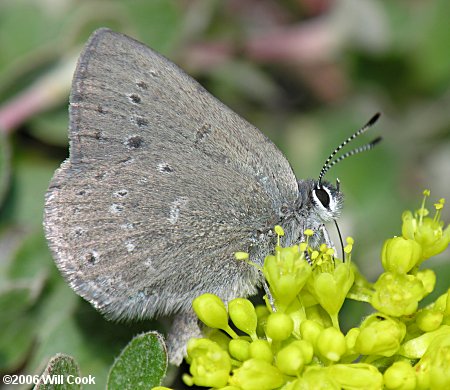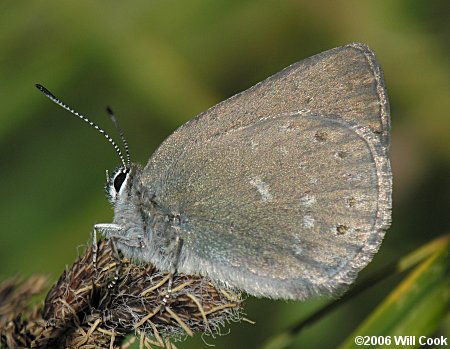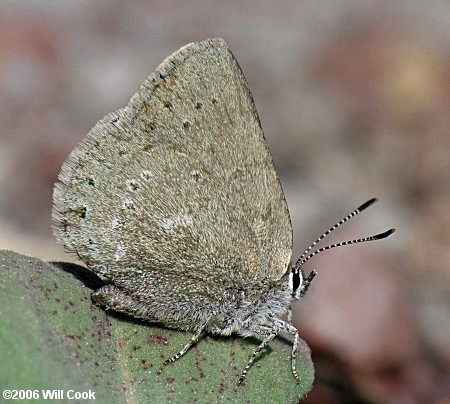Sagebrush Sooty Hairstreak (Satyrium semiluna)

| The appropriately named Sooty Hairstreak is a very unusual Satyrium species - tailless and sooty gray, matching the sooty gray volcanic landscape. They're quite common above Timberline Lodge at Mount Hood, where their caterpillar host plants, lupines (Lupinus) grow. This is an unusually well marked, fresh individual. Mt. Hood, Clackamas Co., OR 8/7/06. |

| They frequently nectar on various Eriogonum species. This one is on Eriogonum umbellatum (Sulphur-flowered Buckwheat), which is the most abundant species on Mt. Hood. Mt. Hood, Clackamas Co., OR 8/8/06. |

| The pattern is quite similar to that of Boisduval's Blue (Plebejus icarioides), which has a more prominent blackish cell-end bar on the forewing and a whitish fringe. Mt. Hood, Clackamas Co., OR 8/7/06. |

| A worn Boisduval's would look quite similar to a worn Sooty, but even a worn Boisduval's would show a trace of blue above, which Sooty lacks. Mt. Hood, Clackamas Co., OR 8/7/06. |

| Another thing I've noticed from looking at my photos at high resolution is that the top side of antennal club tips of Sooty Hairstreak are tan to orange-brown, while those of Boisduval's Blue are white (though the underside of the antennal clubs can be orangish). If this is consistent and still true for very worn individuals, it might help ID some tricky individuals. Mt. Hood, Clackamas Co., OR 8/7/06. |

| The taxonomic status of various populations of Sooty Hairstreak is confusing. The high-elevation population of S. semiluna photographed here flies in late summer, but nearby is a middle-elevation population that flies in May. The Sagebrush Sooty Hairstreak (S. semiluna) was recently elevated to species status. It differs subtly in wing shape and structure from S. fuliginosum. The largest difference is found only in males -- males of S. semiluna possess forewing stigmata, which male S. fuliginosa completely lack. The stigma is on the upper surface of the forewing, so you can't see it these photos. Andy Warren discusses the differences in detail in his 2005 book "Butterflies of Oregon: Their Taxonomy, Distribution, and Biology. Mt. Hood, Clackamas Co., OR 8/7/06. |

| Sagebrush Sooty Hairstreak and Square-spotted Blue habitat above Timberline Lodge on Mt. Hood, Clackamas Co., OR 8/7/06. |